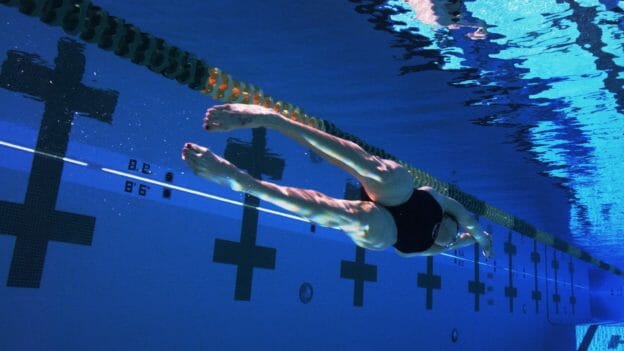Kelsi Worrell has a very fast swimming dolphin kick. After studying her Velocity Meter recently, I now understand why. While kicking on the stomach, poor dolphin kickers will have just one moment of significant acceleration during the dolphin kick cycle, which occurs at the beginning of the strong down kick. Most good dolphin kickers typically have two moments of acceleration during the dolphin kick cycle; one at the beginning of the down kick and the other at the beginning of the up kick. Kelsi has four points of acceleration; two at the beginnings of the up and down kicks, and two more as her feet pass through the body’s vortex or slipstream on the way up and on the way down.
The flow dynamics behind the swimmer are very different than in front of the swimmer, due to the vortices (wakes) or slipstreams that form behind the body and feet. Talented swimmers like Kelsi have learned to use these vortices to their advantage. Because the human body has a non-streamlined shape, a swimmer will form a vortex, or a small stream of water that flows behind him or her in the direction he or she is swimming. If you have ever left 2 seconds behind a swimmer in a lane and remain close to his or her feet, you certainly understand the concept of drafting, or riding the slipstream. The bigger the swimmer’s body and the faster he or she is moving, the bigger and stronger the vortex or slipstream becomes.
There is second vortex that occurs during the dolphin kick and that is from the motion of the feet as they move up, down, or forward through the water from one side of the body to the other. Since the feet are smaller than the body, this second vortex is also smaller, yet it is extremely important in the acceleration that occurs at the beginnings of the down kick and the up kick.
During the down and up kicks, the feet are moving mostly straight down or straight up. There is almost no movement backward of the feet relative to a stationary point in the pool. Because of the two vortices of the feet and body creating a forward-moving stream, the feet are able to create propulsion as they traverse the slipstreams caused by both of them. The amount of the swimmer’s acceleration and ultimately, his or her velocity, depends very much on the speed and surface area when the feet move through these vortices. By moving the feet quickly and aggressively through these vortices, a swimmer can actually speed up, rather than slow down, and keep his or her speed more constant.
Here are two really important ways you can improve the speed of your dolphin kick:
- On the initiation of the down kick, snap the feet down very aggressively, but don’t stop there. Continue the force and speed of the feet until they pass through the body vortex (horizontal line behind the swimmer)
- On the initiation of the up kick, pull the feet and legs up aggressively, but don’t stop pulling until the feet pass through the body vortex (horizontal line behind the swimmer)
Once the feet pass through the body’s slipstream, and the legs extend beyond the horizontal position in either direction, bad things begin to happen. You will start to slow down. In the next article, we will tell you how to minimize the damage from deceleration at that point.
Yours in swimming,
Gary Sr.

